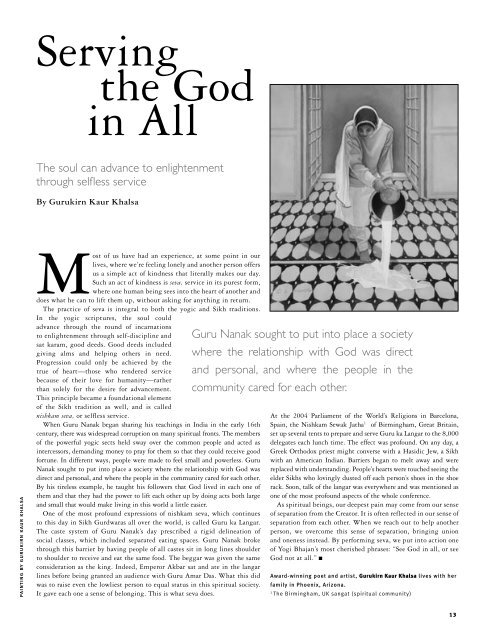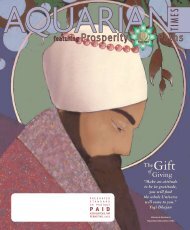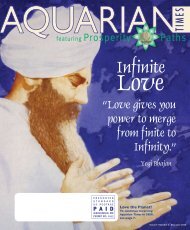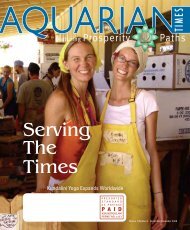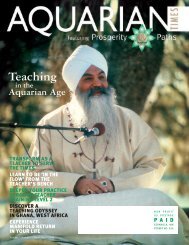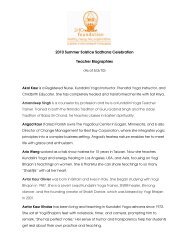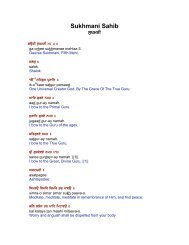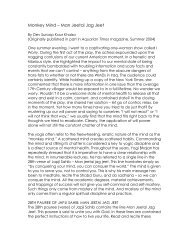Spirit - 3HO
Spirit - 3HO
Spirit - 3HO
You also want an ePaper? Increase the reach of your titles
YUMPU automatically turns print PDFs into web optimized ePapers that Google loves.
painting by gurukirn kaur khalsa<br />
Serving<br />
the God<br />
in All<br />
The soul can advance to enlightenment<br />
through selfless service<br />
By Gurukirn Kaur Khalsa<br />
Most of us have had an experience, at some point in our<br />
lives, where we’re feeling lonely and another person offers<br />
us a simple act of kindness that literally makes our day.<br />
Such an act of kindness is seva, service in its purest form,<br />
where one human being sees into the heart of another and<br />
does what he can to lift them up, without asking for anything in return.<br />
The practice of seva is integral to both the yogic and Sikh traditions.<br />
In the yogic scriptures, the soul could<br />
advance through the round of incarnations<br />
to enlightenment through self-discipline and<br />
sat karam, good deeds. Good deeds included<br />
giving alms and helping others in need.<br />
Progression could only be achieved by the<br />
true of heart—those who rendered service<br />
because of their love for humanity—rather<br />
than solely for the desire for advancement.<br />
This principle became a foundational element<br />
of the Sikh tradition as well, and is called<br />
nishkam seva, or selfless service.<br />
When Guru Nanak began sharing his teachings in India in the early 16th<br />
century, there was widespread corruption on many spiritual fronts. The members<br />
of the powerful yogic sects held sway over the common people and acted as<br />
intercessors, demanding money to pray for them so that they could receive good<br />
fortune. In different ways, people were made to feel small and powerless. Guru<br />
Nanak sought to put into place a society where the relationship with God was<br />
direct and personal, and where the people in the community cared for each other.<br />
By his tireless example, he taught his followers that God lived in each one of<br />
them and that they had the power to lift each other up by doing acts both large<br />
and small that would make living in this world a little easier.<br />
One of the most profound expressions of nishkam seva, which continues<br />
to this day in Sikh Gurdwaras all over the world, is called Guru ka Langar.<br />
The caste system of Guru Nanak’s day prescribed a rigid delineation of<br />
social classes, which included separated eating spaces. Guru Nanak broke<br />
through this barrier by having people of all castes sit in long lines shoulder<br />
to shoulder to receive and eat the same food. The beggar was given the same<br />
consideration as the king. Indeed, Emperor Akbar sat and ate in the langar<br />
lines before being granted an audience with Guru Amar Das. What this did<br />
was to raise even the lowliest person to equal status in this spiritual society.<br />
It gave each one a sense of belonging. This is what seva does.<br />
Guru Nanak sought to put into place a society<br />
where the relationship with God was direct<br />
and personal, and where the people in the<br />
community cared for each other.<br />
At the 2004 Parliament of the World’s Religions in Barcelona,<br />
Spain, the Nishkam Sewak Jatha 1 of Birmingham, Great Britain,<br />
set up several tents to prepare and serve Guru ka Langar to the 8,000<br />
delegates each lunch time. The effect was profound. On any day, a<br />
Greek Orthodox priest might converse with a Hasidic Jew, a Sikh<br />
with an American Indian. Barriers began to melt away and were<br />
replaced with understanding. People’s hearts were touched seeing the<br />
elder Sikhs who lovingly dusted off each person’s shoes in the shoe<br />
rack. Soon, talk of the langar was everywhere and was mentioned as<br />
one of the most profound aspects of the whole conference.<br />
As spiritual beings, our deepest pain may come from our sense<br />
of separation from the Creator. It is often reflected in our sense of<br />
separation from each other. When we reach out to help another<br />
person, we overcome this sense of separation, bringing union<br />
and oneness instead. By performing seva, we put into action one<br />
of Yogi Bhajan’s most cherished phrases: “See God in all, or see<br />
God not at all.” +<br />
Award-winning poet and artist, Gurukirn Kaur Khalsa lives with her<br />
family in Phoenix, Arizona.<br />
1 The Birmingham, UK sangat (spiritual community)<br />
13


